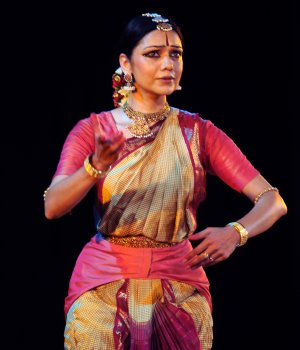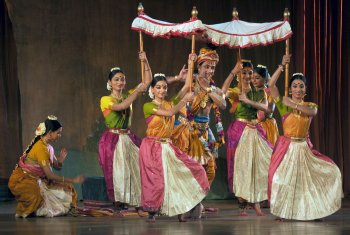
|   |

|   |
Madras Music Academy dance festival: Day 1 - Veejay Sai e-mail: vs.veejaysai@gmail.com Photos courtesy: Madras Music Academy January 10, 2013 The one dance festival that really matters in the entire Margazhi took off on a positive note on the 3rd January at the Music Academy. Over the years, this festival has grown to be that glistening cherry on the cake that no one can ignore anymore.  Prof Sudharani Raghupathy receiving the brochure from Ms. Jennifer A. Mcintyre In a glittering ceremony, this year’s prestigious ‘Natya Kala Acharya’ award was conferred upon the one and only Prof. Sudharani Raghupathy by N Murali, the president of the Music Academy and Ms Jennifer Macintyre, the consul general of the Consulate General of the USA. What an epitome of grace and charm Sudharani continues to remain! A real guru from whom most of today’s dancers can learn life-lessons from and stay inspired. In her acceptance speech the benevolent Sudharani announced that she would donate all her priceless books on dance to the Music Academy’s archives. In a day and age when gurus are busy fighting cold wars and exhibiting their selfishness, it takes great amount of courage, generosity and a big heart to do this act. Hopefully students of dance will enrich their knowledge from all this magnanimity. After the awards ceremony, the festival began with the performance of Rama Vaidyanathan. Loudness invades subtlety Everyone knows and unequivocally agrees that the Madras Music Academy is one of the finest venues for dance in the whole Margazhi season. It is every dancer’s and musician’s dream venue to perform there. But musicians who accompany dancers must not forget that they are there for a different purpose. And this is exactly what happened in Rama’s performance. But before all that, let’s go through the performance itself.  Rama opened her show with ‘Aalokaye shri balakrishnam’, an oft-sung Narayana Theertha tarangam. Depicting Krishna the cowherd tending to his flock, Rama described earlier how she interpreted this flock as human souls and Krishna was the point of divine union, beyond the snares of samsara. The freshness of Karaikudi Sivakumar’s jatis along with the choreography recreated Krishna’s leelas on stage. From there she continued into the oft-done ‘Mohamana’ varnam by the Thanjavur quartet. This time around the varnam got another shade of colourful interpretation in Rama’s style. Taking the ‘Ajapa’ dance from the Thiruvarur Tyagaraja temple, she narrated the story of the nayika who pines for Lord Shiva who is dancing in the heart of reclining Vishnu. One would have loved it if Rama had cited the mythological source and tale related to this fancy story. Hindu mythology is full of fancy narratives and when someone discovers something, especially something that has never been performed to dance on stage, it just increases one’s curiosity. The choreography also seemed to constrict Rama’s movements and she didn’t come forth as giving her total self this time around. Added to this was Sudha Raghuraman’s singing. Now we all have seen how wonderfully talented a singer Sudha is. Time and again she has proved herself to be a fine voice for dancers. Unfortunately this time around an overwhelmed Sudha overdid her singing, often going beyond her limits and that affected the dance. Rama continued her performance into a composition praising Lord Krishna in ragam Behag taken from the Bhajana Sampradaya. ‘Moomu Joopara’ asking Krishna to show his wonderful face meant three different stages of desire. One was to see his physical face, the second the naughty butter-thief who is caught red-handed and the third is the eternal cosmic form of the Vishwaroopam. While Rama’s abhinaya was excellent in this piece, Sudha’s Telugu pronunciation while singing ‘Mannu thinale atanchu’ got a bit wayward. The next piece was Arunachala Kavi’s famous ‘Eppadi manam tunindado’ in ragam Husseini set to misra chapu talam. Sita’s plea to Rama to take her to the forest fell on deaf ears. If only Sudha’s singing had been a bit softer, Sita wouldn’t have needed to do so much pleading. Rama ended her show in a Dvijawanti Thillana, a classic composition of Dr. Mangalampalli Balamurali Krishna that continued into an Annamayya Keertana ‘Radha Madhava Rati Charitam’ that extolled the love-sports of the lord. All old, not so gold Kalakshetra’s ‘Geeta Govindam’ is a significant production for various reasons. Firstly, it defined in many ways what the founder Rukmini Devi Arundale stood for in her philosophy on ideas like bhakthi and shringaaram. And secondly, because Kalakshetra is usually superb in their group productions, in spite of all the accusations anyone makes on their dance and style. The students understand good teamwork and exhibit their talent with finesse. Last year at the Music Academy’s dance festival, their production stood out as one of the finest. Unfortunately this year they seemed to have lost all that sheen. Presenting ‘Geeta Govindam’ that was first performed in 1959 under the guidance of Rukmini Devi must have been a mind-blowing experience during that time.  We all know Rukmini Devi did the first choreography, but she did it according to the times that suited her era. She herself would have appreciated something fresh to suit today’s times. This year’s ‘Geeta Govindam’ production turned out to be outright mediocre. If not for the original music score by Papanasam Sivan and some excellent vocals by Sai Shankar (who has a huge appetite to sing nonstop!), there was nothing much in the show worth talking about, except for some of the group dance sequences that had patches of good nritta. A faded background added to the monotony. One wondered where all the shringaram was, that poet Jayadeva wrote in his magnum opus. How much of it can be the same desperate attempt at morphing anything remotely erotic into jeevatma-paramatma stereotyped equations? More so, what is the big deal about being true to what the content has to convey? Krishna had a fixed expression on his face and the gopikas looked like they were part of a high school drill. One would have expected Kalakshetra to put up a better show considering their undiluted expertise in large-scale group productions. To perform this particular edition on the most enviable opening day of the Academy’s festival was yet another cause of depression for most of those who left the show mid-way. We hope they do something better the coming year. Veejay Sai is a writer, editor and a culture critic. |